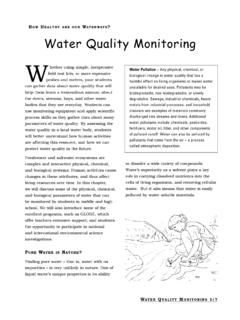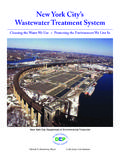Transcription of Immune Problems DRINKING WATER 281-861-7265 …
1 2 017 DRINKINGWATERQUALITYREPORTHARRIS COUNTYMUNICIPAL UTILITY DISTRICTNO. 208 PWD ID#: 1012419 ABOUT OUR DRINKING WATERThe Texas Commission on environmental quality (TCEQ) has assessed our system and determined that our WATER is safe to drink. This analysis is based on the data in the attached tables. If your WATER meets federal standards there may not be any health benefits to purchasing bottled WATER or point-of-use devices. Harris County Municipal Utility District No. 208 has been awarded the Superior WATER rating by the DO WE GET OUR WATER ?
2 Our DRINKING WATER is obtained from a combination of ground WATER and surface WATER and is blended at our WATER plant. Texas Commission on environmental quality completed an assessment of your source WATER and results indicate that some of our sources are susceptible to certain contaminants. The sampling requirements for your WATER system are based on this susceptibility and previous sample data. Any detections of these contaminants will be found in this Consumer Confidence Report. If we receive or purchase WATER from another system, their susceptibility is not included in this report.
3 For more information on source WATER assessments and protection efforts visit Texas DRINKING WATER Watch at HEALTH INFORMATION FOR LEADIf present, elevated levels of lead can cause serious health Problems , especially for pregnant women and young children. Lead in DRINKING WATER is primarily from materials and components associated with service lines and home plumbing. We are responsible for providing high quality DRINKING WATER , but we cannot control the variety of materials used in plumbing components. When your WATER has been sitting for several hours, you can minimize the potential for lead exposure by flushing your tap for 30 seconds to two minutes before using WATER for DRINKING or cooking.
4 If you are concerned about lead in your WATER , you may wish to have your WATER tested. Information on lead in DRINKING WATER , testing methods, and steps you can take to minimize exposure is available from the Safe DRINKING WATER Hotline or at SOURCESThe sources of DRINKING WATER (both tap and bottled WATER ) include rivers, lakes, streams, ponds, reservoirs, springs, and wells. As WATER travels over the surface of the land or through the ground, it dissolves naturally occurring minerals and in some cases, radioactive material, and can pick up substances resulting from the presence of animals or from human that may be present in source WATER prior to treatment include: Microbial contaminants, such as viruses and bacteria, which may come from sewage treatment plants, septic systems, agricultural livestock operations, and wildlife.
5 Inorganic contaminants, such as salts and metals which can be naturally-occurring or result from urban stormwater runoff, industrial or domestic wastewater discharges, oil and gas production, mining, and farming. Pesticides and herbicides, which may come from a variety of sources such as agriculture, urban stormwater runoff, and residential uses. Organic chemical contaminants, including synthetic and volatile organic chemicals which are by-products of industrial processes and petroleum production, and can also come from gas stations, urban stormwater runoff, and septic systems.
6 Radioactive contaminants, which can be naturally-occurring or be the result of oil and gas production and mining order to ensure that tap WATER is safe to drink, the environmental Protection Agency (EPA) prescribes regulations which limit the amount of certain contaminants in WATER provided by public WATER systems. Federal Food and Drug Administration Agency regulations establish limits for contaminants in bottled WATER which must provide the same protection for public NOTICE For the Elderly, Infants, Cancer Patients, People with HIV/AIDS or Other Immune ProblemsYou may be more vulnerable than the general population to certain microbial contaminants such as Cryptosporidium, in DRINKING WATER .
7 Infants, some elderly, or immuno-compromised persons such as those undergoing chemotherapy for cancer; persons who have undergone organ transplants; those who are undergoing treatment with steroids; and people with HIV/AIDS or other Immune system disorders can be particularly at risk from infections. You should seek advice about DRINKING WATER from your physician or health care provider. Additional guidelines on appropriate means to lessen the risk of infection by Cryptosporidium are available from the Safe DRINKING WATER Hotline: you would like to talk to a District representative about your WATER quality Report, please call 281-861-7265 .
8 For more information from the environmental Protection Agency, you may call the EPA s Safe DRINKING WATER Hotline at espa ol: Este reporte incluye informaci n importante sobre el agua para tomar. Para asistencia en espa ol, favor de llamar al telefono PARTICIPATION OPPORTUNITIESThe Board of Directors of Harris County MUD No. 208 meet at 12:00 PM on the third Friday of each month at Norton Rose Fulbright 1301 McKinney, Houston, TX. You may mail comments to:Harris County MUD No. 208 Attn.: Board of Directors5870 Highway 6 North, Suite 215 Houston, TX 77084Or call 281-861-7265 HARRIS COUNTY MUNICIPAL UTILITY DISTRICT NO.
9 2085870 Highway 6 North, Suite 215 Houston, TX 77084281-861-7265 ALL DRINKING WATER MAY CONTAIN CONTAMINANTSWhen DRINKING WATER meets federal standards there may not be any health based benefits to purchasing bottled WATER or point of use devices. DRINKING WATER , including bottled WATER , may reasonably be expected to contain at least small amounts of some contaminants. The presence of contaminants does not necessarily indicate that WATER poses a health risk. More information about contaminants and potential health effects can be obtained by calling the EPA s Safe DRINKING WATER Hotline CONSTITUENTSMany constituents (such as calcium, sodium, or iron) which are often found in DRINKING WATER , can cause taste, color, and odor Problems .
10 The taste and odor constituents are called secondary constituents and are regulated by the State of Texas, not the EPA. These constituents are not necessarily causes for health concern. Therefore, secondaries are not required to be reported in this document, but they may greatly affect the appearance and taste of your WATER . For more information on secondary constituents contact H2O Consulting at THE TABLESThe attached table contains all of the chemical contaminants which have been found in your DRINKING WATER .







